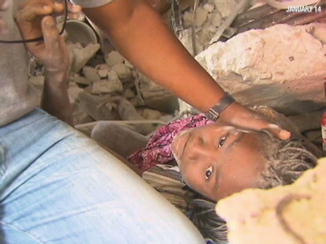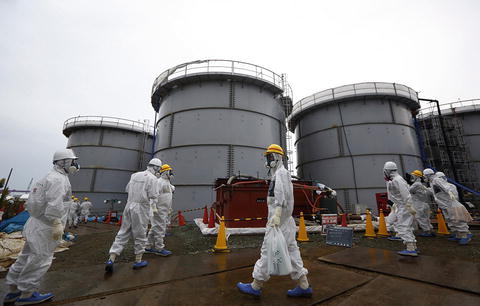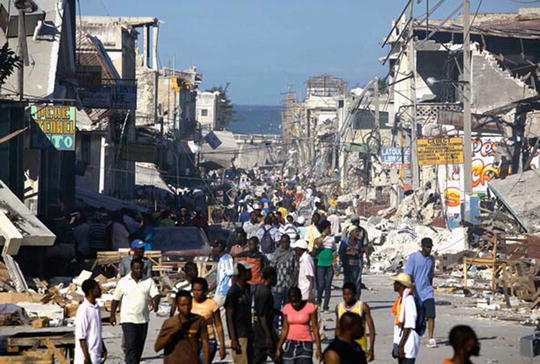Worldwide demographic analysis has proven that many heavily concentrated populations are located along major fault lines [3]. Such population trends predispose large numbers of people to the risks and complications associated with earthquakes. The most common causes of injury and/or death are crush injuries and the development of compartment syndrome. It has been shown that patient survival is inversely related to the amount of time necessary for extrication from collapsed buildings and structures damaged by the seismic activity [3]. The Haiti Earthquake occurred on January 12, 2010, and registered as a catastrophic magnitude 7.0 Mw. Occurring roughly 16 miles from the capital city of Port-au-Prince, the earthquake was, paradoxically, not proven to involve slipping of faults, the major cause of prior significant earthquakes. This earthquake’s effects were felt by over 3.5 million people. The earthquake’s intensity was severe enough to cause moderate-to-heavy damage to structures deemed earthquake resistant. The shallow depth of the earthquake zone was postulated as the reason for its intensity [4]. It has been postulated that roughly 222,570 people lost their lives in this earthquake, while some 300,572 were injured. The estimated financial damage caused by this devastation tallied nearly $7.8 billion US dollars ($4.3 billion in physical damages and roughly $3.5 billion dollars in economic losses) [5]. Other notable causes of morbidity surrounding the initial devastation caused by an earthquake include secondary events such as fires, landslides, tsunamis, and exposure to toxic chemicals secondary to the destruction of chemical stores/plants [3]. See Fig. 23.2


Fig. 23.2
Haiti earthquake destruction. http://www.scholastic.com/content/images/articles/sn_ts/sn_ts_011510_hdr.jpg
March 11, 2011, was a day that changed the lives of many, if not most, on the eastern coast of Japan. The Tohoku earthquake, which registered at a magnitude of 9.0 Mw, compared to the Haiti earthquake which was recorded at a magnitude of 7.0 Mw, occurred nearly 43 miles off of the eastern coast of the Oshika Peninsula of Tohoku. The subsequent tsunami created waves as high as 133 feet which traveled nearly 6 miles inland. It is of little surprise that the devastation of such a massive earthquake and tsunami would top those created by the Haiti Earthquake of 2010. One year after the traumatic occurrence, reports had documented 16,273 fatalities, 3,061 missing, and 27,074 people injured with these numbers continually growing [6]. Unique to this particular disaster is the fact that there were two separate natural disasters which synergistically caused unimaginable destruction and changed the eastern coast of Japan forever. At the 1-year mark, damages were estimated roughly at $275 billion US dollars. It is now believed that the earthquake alone would have caused 40–45 % of the total damage surrounding this catastrophe [7]. See Fig. 23.3.


Fig. 23.3
Tohoku earthquake and Tsunami. http://www.elist10.com/wp-content/uploads/2013/03/T%C5%8 Dhoku-Japan-earthquake-2011.jpg
There have been many forest fires in the US, but the densest concentrations of these disasters have occurred on the Pacific coast. California has witnessed multiple incidents with the most devastating occurring between October 25th and October 29th of 2003. A series of 15 wildfires cumulatively coined the “2003 Firestorm” was noted to cause 24 deaths while destroying nearly 800,000 acres including 3,640 homes throughout the San Diego, Ventura, Riverside, and San Bernadino counties [8]. Although not as costly as the previously discussed natural disasters, there was widespread criticism by review committees as to the preparation and response to the disaster.
As a consequence of geographical location on the Ganges Delta, a tributary system which feeds into the Bay of Bengal, and the Himalayas, the country of Bangladesh is continually at risk for widespread destruction secondary to torrential floods during the monsoon season (June through September). 75 % of the landscape of Bangladesh is within 10 m of sea level with 80 % of this land being comprised of flood plains. With the rains provided by the monsoon season coupled with the rain and melting water runoff of the Himalayas, nearly two-thirds of the country are flooded annually despite ongoing attempts to improve the infrastructural stability designs specifically created to combat the well-known, recurring devastation. The most destructive flood witnessed by the country occurred in 1998 leaving 75 % of the country’s land was left under water due to the rains occurring between August and September of that year. The heavier than normal rains led to the three-river system within Bangladesh reaching peak flow levels. The additional factors of global warming and above average melting of snowmelt on the Himalayas further exacerbated the annually anticipated flooding of the region causing over 1,000 deaths and forcing 30,000+ people to become homeless. Undercut by flooding and overcrowding, many victims perished as a consequence of everyday injuries and otherwise treatable medical conditions. Contamination led to both cholera and typhoid outbreaks. Crop and economic production and communication were crippled.
Unnatural Disasters and Malicious Disasters
Unnatural disasters and malicious/ill-intent disasters occur far more frequently than natural disasters but are generally not as catastrophic. Examples of such include plane crashes, train and automobile accidents, explosions, and chemical spills. The most notable of these was the September 11th attacks of 2001 which occurred in New York, Virginia, and Pennsylvania which proved to be the most deadly terrorist-driven attack on United States soil. Four passenger airliners were hijacked and used as weapons to attack both the North and South towers of the World Trade Center, the Pentagon, and Washington D.C. The attacks on the World Trade Center involved two airliners making direct impact with the two towers eventually causing their collapse. The destruction of these two towers took the lives of 2,606 people, including 343 firefighters. The attack on the pentagon killed 125 people and there were a total of 246 people who lost their lives on the four passenger airliners. Estimates point to a total of roughly $2 trillion US dollars when including all economic losses from physical damages and the impact on the stock market [9].
On April 19th, 1995, the Alfred P. Murrah Federal Building in downtown Oklahoma City, Oklahoma fell victim to a domestic terrorist bombing which claimed the lives of 168 people, injured nearly 700 people, and caused roughly $650 million US dollars in damage [10]. Timothy McVeigh, and his co-conspirator Terry Nichols, were soon detained and charged with the crime. Upon interviewing McVeigh in search of a possible motive, he explained that the attack was greatly fueled by his hatred of the Federal Bureau of Investigation (FBI) as a result of what he believed to be mishandling of the Waco Siege which occurred 2 years prior in 1993 as well as the Ruby Ridge incident in 1992 [10]. The premeditated plan was to attack as many federal law-enforcement agencies as possible simultaneously making the Alfred P. Murrah Federal Building a leading target as it housed not only the FBI but also the Drug Enforcement Agency (DEA) and the Bureau of Alcohol, Tobacco, and Firearms (ATF). The man-made bomb harnessed the blast equivalent of 5,000 pounds of TNT and could be heard as well as felt more than 50 miles away upon detonation. See Fig. 23.4.


Fig. 23.4
Oklahoma City bombing. “Oklahoma City Bombing.” Wikipedia, The Free Encyclopedia, 2014. Web. April 19 2014 http://en.wikipedia.org/wiki/2010_Haiti_earthquake
As the Iran-Iraq War came to a close in March of 1988, one of the world’s worst genocidal massacres took place at the hands of the Iraqi regime under Saddam Hussein. The attack involved a series of more than 14 chemical bombings coordinated by helicopters of residential areas in the city of Halabja in Southern Kurdistan. The bombs were noted to contain combinations of sulfur mustard (also known as “mustard gas”), hydrogen cyanide, and other nerve agents. The effects of the nerve gas exposure led to the death of roughly 5,000 people and injured between 7,000 and 10,000 other civilians [11]. The devastation carried on for years after the initial attack as many more people perished from complications including diseases and birth defects. This attack, more commonly referred to as the Halabja Massacre or Bloody Friday, was the largest chemical weapon attack in history against a civilian populated region [11].
Pre-disaster Strategies
Some of the founding principles of the anesthesiology specialty include anticipation, thorough preparedness, hypervigilence, apt problem-solving skills, and sound decision making in critical situations. Anesthetic care providers must have a sense of discipline, dedication, empathy, and determination to respond to emergencies in an attempt to save the lives of victims and treat those injured in the face of catastrophic events. In order to maximize this initiative, there must be great emphasis and effort directed at being prepared. Such preparedness comes by way of identifying and organizing committees, resources, facilities, and personnel that can all be mobilized swiftly and efficiently.
Committees, Roles, and Communication
Organization is imperative to the success of disaster response. Because anesthesiology provides a key linkage between multiple specialties and also holds a central position in most medical care settings, providing the most efficient medical care to those in need should include the direction and coordination of an anesthesiologist. In ideal situations, there should exist a network of local and regional anesthesiology providers who are willing and able to provide their skill sets if called upon in the face of disaster. The creation of a core committee which includes these anesthesiologists as well as other subspecialties including, but not limited to, surgical subspecialties, critical care, nursing, emergency medicine, and internal medicine is essential. This committee will be the central unit in creating disaster management strategies to include pre-disaster awareness, disaster management planning, identifying resources and surplus availability, and creating mock-disaster trials. Given that the remainder of disaster strategy preparedness revolves around this central organization, there should also be elected/selected delegates of this group who hold ranking positions to ensure a tier-structure of command to facilitate instruction and direction in the event of impending catastrophe. The contact information of all ranking and registered providers should be available via various means in the case that activation of the group be needed and established lines of communication are jeopardized or destroyed entirely. Accordingly, all medical professional subspecialties should create similar registries with appointed ranking leaders and individual contact information should there be a breakdown in the ability for there to be a central organization coordinated disaster plan. Within each committee, rank should be appointed based on knowledge and experience within the particular specialty and subsequent positions should be appointed accordingly. It should be left to the discretion of committee leaders to determine the roles and responsibility given to each member. Creating individual committees, with their respective leaders, will ensure that once disaster is suspected or anticipated, all personnel, through a previously designed, or alternative, communication system will be informed and on high-alert that their individual skill sets may be called upon. The delegates of these groups should ensure that their registries are updated at least bi-annually and remain current to the best of their abilities. These appointed leaders would themselves join together to form a Disaster Management Board (DMB) which should similarly include senior ranking members/directors and administrators of all major hospital or health care facilities, local police and fire departments, and the local department of transportation. The DMB collectively formulates disaster plans and strategies built upon previous catastrophic experiences of all etiologies. Regularly scheduled meetings should be held in an attempt to review and update strategies and allocation of resources amongst many other facets of disaster management. These meetings may also be used to simulate potential disaster situations and test the abilities and limitations of the current policies and strategies. McIsaac et al. noted that the Joint Commission on Accreditation of Healthcare Organizations (JCAHO) requires all hospital to have biannual disaster exercises to help ensure proper coordination of operating room (OR) personnel and the department of anesthesiology [12].
It is also important to establish an organized group to be deemed “First Responders.” Ideally this group would comprised a select group of anesthesiology providers as well as surgical specialists of each region. The primary goal of these health care providers is to make initial assessments based on:
1.
The type of disaster and the most common types of injuries (crush, burn, chemical, etc.).
2.
The need for particular types of medical specialists to be dispatched to the scene as well as sufficient numbers of such specialists.
3.
Activation of all participating committees and hospital facilities needed based on the type of care required.
Once the initial assessments have been made and the disaster has been categorized, the DMB should activate predesigned protocols needed for the peri-disaster phase of management.
Communication amongst these committees is essential for initiation of proper disaster response. Particular attention should be given to the widespread distribution of a central set of contacts and contact numbers that others (professionals, administrators, media, etc.) may use for inter-group communication, reports, and updates. There should also be particular attention paid to the types of communications that may be lost given the type of disasters that are most likely to occur. In the event of widespread loss of electricity or cellular technologies, an alternative means for effective communication to facilitate and coordinate the disaster response is warranted. History has shown that the use of two-way radios provides a rather inexpensive means of communication in distances up to 12 miles. The Pan Am 103 flight bombing was an example of abilities of two-way radio communications as the pilots were able to make contact with the Shanwick Oceanic Area Control just seconds before the plane was subsequently destroyed by a terrorist bomb believed to be orchestrated by the regime under Libyan leader Muammar Gaddafi [13]. Ideally in disaster scenarios, the use of two-way radio communication would be able to provide key linkage between first responders and appropriate facilities or personnel in the event that other electricity-driven forms of media/communication were destroyed or rendered inoperable. The implementation of such alternative forms of communications would thus prove to be essential for execution of disaster strategies and providing up-to-date information regarding different aspects of disaster response(s).
Identifying Resources and Materials
Each DMB needs to identify potential resources and materials that can be mobilized in the event of a disaster which will require the input of hospitals and other medical facilities. Information that is usually needed includes, but is not be limited to, the numbers of hospital beds, including emergency room capacities, ICU and inpatient beds, functioning operating rooms (ORs), functioning mechanical ventilators, and emergency transportation vehicles (ambulances, fire trucks, other emergency vehicles).
It would be of great value to create a registry of approximate volumes of necessary resources particularly those that are more likely to be exhausted during a disaster situation. Of particular importance are the emergency medications that are specific to the treatment protocols of certain chemicals and nerve gases in the event of bio- or chemical disaster as well as those necessary to perform a wide array of anesthetics depending on the clinical scenario. The anesthesiologist must have the ability to treat patients both in and out of the hospital setting as it has been shown that the degree and types of injuries vary widely depending on the etiology of the disaster. The ability of the anesthesia provider to administer adequate clinical care for patients is heavily dependent on his/her ability to construct anesthetic regimens based on individual clinical conditions. The anesthetic regiment may consist of particular drugs which provide better hemodynamic control in the face of severe traumatic injuries. Of particular note, patients who have succumbed to collapsing infrastructures and whose survival is dependent on emergency surgeries involving amputation of a limb pose a difficult, yet manageable, anesthetic scenario for the anesthesia provider as securing of a patient’s airway may be impossible. In these dire circumstances, the anesthesia provider would be best served in utilizing medications whose side effect profile minimizes the possibility of respiratory depression (i.e. ketamine, non-steroidal anti-inflammatory drugs (NSAIDs)) but are capable of providing analgesia. See Fig. 23.5.








